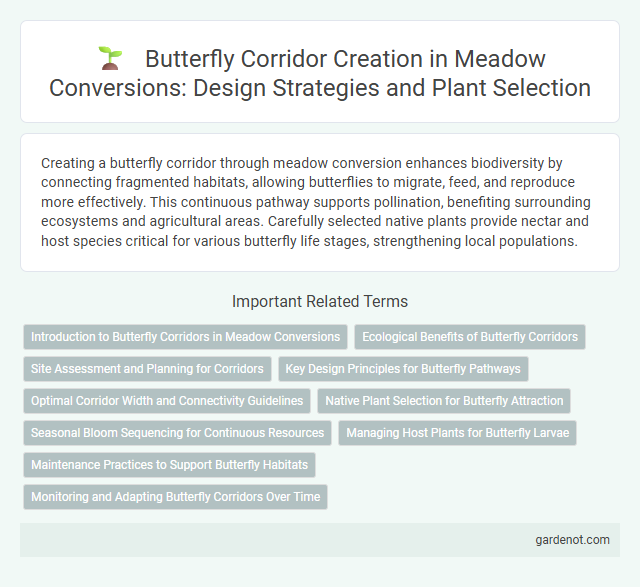Creating a butterfly corridor through meadow conversion enhances biodiversity by connecting fragmented habitats, allowing butterflies to migrate, feed, and reproduce more effectively. This continuous pathway supports pollination, benefiting surrounding ecosystems and agricultural areas. Carefully selected native plants provide nectar and host species critical for various butterfly life stages, strengthening local populations.
Introduction to Butterfly Corridors in Meadow Conversions
Butterfly corridors in meadow conversions serve as vital pathways that connect fragmented habitats, enabling butterflies to migrate, forage, and reproduce effectively. These corridors enhance biodiversity by supporting various butterfly species, particularly pollinators crucial for ecosystem health and plant reproduction. Integrating butterfly corridors into meadow restoration projects promotes ecological connectivity and helps maintain sustainable butterfly populations.
Ecological Benefits of Butterfly Corridors
Butterfly corridors enhance biodiversity by connecting fragmented habitats, allowing species to migrate, feed, and reproduce more effectively. These corridors support pollination, which improves plant health and ecosystem resilience, contributing to overall ecological balance. Maintaining continuous butterfly corridors helps sustain population genetic diversity, reducing the risk of local extinctions.
Site Assessment and Planning for Corridors
Site assessment for butterfly corridors involves detailed mapping of existing habitats, identification of nectar sources, host plants, and potential barriers to migration. Planning integrates ecological connectivity by selecting strategic meadow locations that maximize pollinator movement and genetic exchange. Using geospatial analysis and environmental data ensures corridors support diverse butterfly species and enhance regional biodiversity.
Key Design Principles for Butterfly Pathways
Key design principles for butterfly pathways emphasize creating continuous, nectar-rich corridors that connect isolated habitats to support species mobility and genetic diversity. Incorporating native flowering plants with staggered bloom times ensures year-round food sources, while maintaining shelter through grasses and shrubs provides vital protection from predators and weather. Structural diversity, including varying plant heights and open sunny areas, optimizes microclimates essential for different butterfly life stages.
Optimal Corridor Width and Connectivity Guidelines
Optimal corridor width for butterfly conservation typically ranges between 30 to 60 meters, ensuring sufficient habitat quality and shelter. Connectivity guidelines emphasize minimizing habitat fragmentation by linking meadows through continuous vegetative cover, facilitating butterfly movement and genetic exchange. Adequate corridor design enhances pollinator diversity and supports long-term population resilience in meadow ecosystems.
Native Plant Selection for Butterfly Attraction
Selecting native plants such as milkweed, purple coneflower, and goldenrod is essential for creating an effective butterfly corridor during meadow conversion. These species provide crucial nectar sources and host plants that support butterfly life cycles, from egg to adult. Incorporating a diverse array of native flowering plants ensures continuous bloom periods, maximizing butterfly attraction and habitat sustainability.
Seasonal Bloom Sequencing for Continuous Resources
Seasonal bloom sequencing in butterfly corridors ensures continuous availability of nectar and host plants, supporting diverse butterfly species throughout their life cycles. Strategic planting of early, mid, and late-blooming native wildflowers maximizes habitat connectivity and resource abundance. This approach enhances pollinator health and promotes sustainable meadow ecosystems by sustaining butterfly populations across changing seasons.
Managing Host Plants for Butterfly Larvae
Maintaining a diverse array of native host plants such as milkweed, violets, and goldenrod is essential for supporting butterfly larvae development within butterfly corridors. Strategic planting and periodic monitoring of these species ensure optimal nutritional resources and habitat continuity for caterpillars. Effective management practices also involve controlling invasive plants that compete with host species, thereby enhancing larval survival and butterfly population growth.
Maintenance Practices to Support Butterfly Habitats
Regular mowing schedules and selective brush cutting maintain open, nectar-rich meadows essential for butterfly foraging and breeding. Planting native wildflowers and controlling invasive species ensure the availability of host plants critical for caterpillar development. Implementing pesticide-free zones and providing overwintering sites promote healthy butterfly populations within the corridor.
Monitoring and Adapting Butterfly Corridors Over Time
Monitoring butterfly corridors involves regular surveys to track species diversity, population changes, and habitat health, using tools like GIS mapping and automated sensors. Data collected enables adaptive management, such as adjusting native plant species composition or corridor width to enhance nectar sources and breeding sites. Long-term monitoring supports resilience by identifying climate impact trends, guiding restoration efforts that maintain continuous habitats and connectivity for migratory butterflies.
Butterfly corridor Infographic

 gardenot.com
gardenot.com